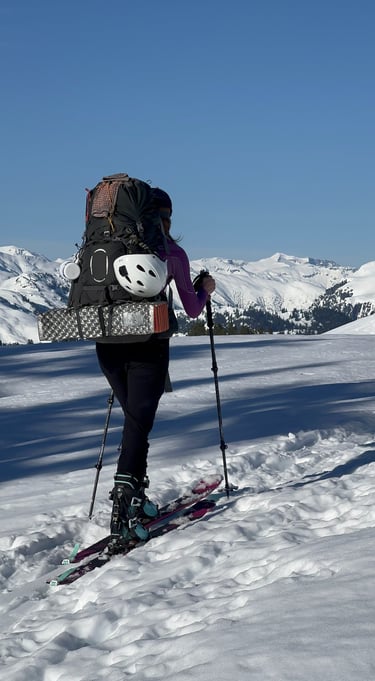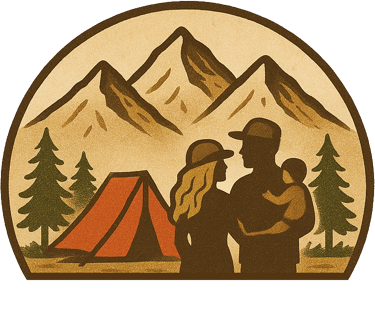Beginner Ski Touring Routes in the Lower Mainland
From stunning alpine views to cozy backcountry shelters, these trails offer the perfect mix of safety and adventure to help you build confidence. Ready to find your next ski touring spot? Let’s get into it.
SKI TOURING
Jan
5/8/20244 min read
So, you’ve decided to give ski touring a shot! As you get started, it’s essential to choose routes that allow room for a few mistakes and help you learn best practices—what to watch out for, how to spot potential hazards, and how to manage risks effectively.
For your first few tours, it’s best to stick to routes that are both safe and enjoyable, ensuring you’re not crossing any lines that might make you hesitant to get back out there. The primary risk in ski touring is avalanche danger, so aim for routes with low-angle slopes and minimal overhead hazards.
Here are some of the routes I started with, which I’d recommend to any beginner looking to get comfortable with ski touring. Read on carefully—while these routes are beginner-friendly, even the easiest trails have their ups and downs.
Before we dive in, a quick reminder: this article is not a guide. Use it as inspiration, and be sure to complete Avalanche Safety Training (AST) before venturing into the winter backcountry on your own. Your safety is in your hands!
Elfin Lakes
Elfin Lakes was one of our first ski touring experiences, offering incredible views of Mamquam Mountain and Diamond Head. This trail lets you explore the high alpine, and if you're lucky, you’ll be able to put your skis in walk mode right from the start—but don’t count on it! 😉
The first section of the trail follows the same path as the summer route, taking you through a gradual elevation gain into the alpine. The trail is generally safe, but keep in mind that the length and time to the destination can differ when traveling on snow and shorter winter days.
Once you reach the Red Heather Shelter, you’ll continue along the ridge with spectacular views. Stay focused as you’ll come across a split in the trail with options for the summer or winter route. Be sure to follow the winter trail, which stays atop the ridge, crossing Round Mountain instead of passing its slope to reduce avalanche risk. This route is marked with wooden stakes that also indicate snow depth. The section is about 5.5 km long and leads to the Elfin Lakes Shelter.
I’d highly recommend making a reservation to stay overnight here. It’s a larger hut that accommodates 33 people, with 11 double bunk beds and 11 single bunks. There’s nothing like drying off, having a hot tea, and enjoying the cozy backcountry vibes in winter. If you’re up for more and conditions are good, you can extend the trip to the Gargoyles for some extra skiing—though be aware this section is more challenging and less enjoyable for beginners.
Keith’s Hut
The farthest trail from Vancouver on this list takes you to the east side of the Joffre Lakes area, in the Nlhaxten / Cerise Creek Wilderness Conservancy. It’s a shorter route than Elfin Lakes, but don’t let that fool you! While the trail to Keith’s Hut is generally mellow, you’ll need to cross Cerise Creek, which can be tricky, especially during the shoulder seasons when snow coverage may be thin and the creek is exposed. Be cautious and look for fresh ski tracks to find the safest crossings.
This area is also prone to landslides; the most recent large slide occurred in 2019. Avoid traveling within the immediate slide path and stick to the designated trail. The final approach to the hut offers some enjoyable skiing, and if conditions allow, you can continue above the hut to Motel 66. However, I’d only recommend this extension for those with Avalanche Safety Training (AST 1) experience, as it involves alpine terrain with higher avalanche risks.
Keith’s Hut is a cozy spot with basic amenities, including a cooking area, a large dining table, a fireplace to dry your clothes, an outdoor pit toilet, and loft space designed for 14 people, with two benches and additional floor space if needed. The hut operates on a first-come, first-served basis, so on busy weekends, it’s advisable to bring a tent in case there’s no room. It’s a lovely place to relax after a day of skiing in surrounding area!
Pump Peak
If you’re looking to stay close to the city, Pump Peak is an excellent option for a weekend ski touring day trip. Since there’s no hut here, it’s a day destination, but you could bring a tent for an overnight stay if you’re equipped with winter camping gear (camping is only permitted beyond Brockton Point).
Even though it’s close to the city, make sure to follow the designated uphill route, as travelling up ski runs is prohibited. The descent can also be tricky—there are a few slopes with significant avalanche risk, and the final approach is rated as challenging by Avalanche Canada due to complex terrain nearby. Watch out for terrain traps; the North Shore mountains are known for steepening as you descend lower off the trail.
Since this can easily be a day trip, consider timing your visit for sunset. On clear days, the view of the ocean and city is breathtaking. Just remember not to linger too long—you’ll want to avoid skiing down in the dark, and it’s wise to bring a headlamp just in case. 😉
Stats
Distance: 11.7 km / 7.3 mi roundtrip
Elevation gain: 615 m / 2017 ft
Driving time from Vancouver: 3 hours
Amenities: 14 people loft space, cooking area, big dining table, outdoor pit toilet
More info: Keith's Hut
Stats
Distance: 20 km / 12.4 mi roundtrip
Elevation gain: 920 m / 3018 ft
Driving time from Vancouver: 1.5 hours
Amenities: 33 people bunk beds, cooking area, several dining tables, outdoor pit toilet
More info: Backcountry shelters - Province of British Columbia | BC Parks
Stats
Distance: 6.6 km / 4.1 mi roundtrip
Elevation gain: 476 m / 1561 ft
Driving time from Vancouver: 30-45 min
Amenities: No amenities
More info: Mount Seymour Park


Explore
Inspiring mindful adventures in nature sustainably.
Join the wandering Community
© 2024. All rights reserved.
by @wanderingintwo
